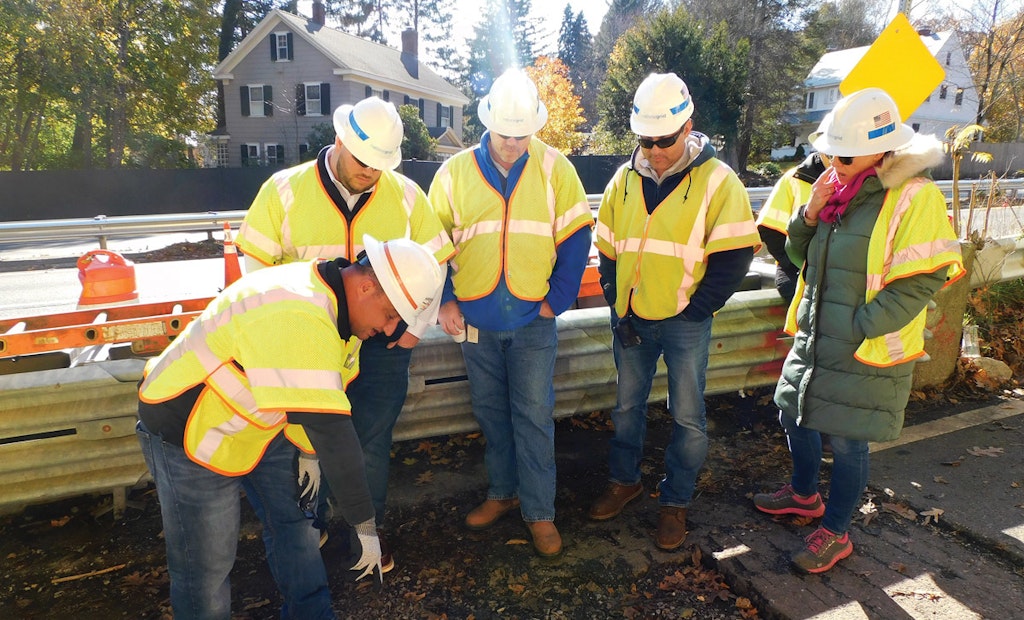
Progressive Pipeline Management conducts a daily briefing on every job site where the supervisor and everyone who is on site reviews the particular hazards that might be encountered that day.
Interested in Safety?
Get Safety articles, news and videos right in your inbox! Sign up now.
Safety + Get AlertsIt takes more than a safety coordinator to produce accident-free work environments. But pairing someone in charge of safety with a team of like-minded individuals is a great step in the right direction for many companies.
Ensuring employees complete jobs safely is no small task. Keeping workers up to date on regulations while monitoring to confirm that correct procedure is being performed in the field can be a full-time job and may very well warrant the need for a dedicated safety manager.
Progressive Pipeline Management has been committed to safely improving the longevity of the pipeline infrastructure in the Wenonah, New Jersey, area since its inception in 2002.
Its safety strategy relies on different people throughout the company, but ultimately falls on one individual. “We have different roles of responsibility when it comes to safety, and each facet of safety in the company is overseen by different personnel,” says Casey Giambrone, vice president of engineering at Progressive Pipeline Management. “Everyone plays their own role, but Claudia Law, our safety coordinator, is the main point of contact in the end.”
What comes with the role
The safety coordinator’s role at PPM begins during the hiring process with overseeing operator qualifications. “Operator qualifications are a big part of our safety protocol,” Giambrone says. “In order to work here, every employee needs to have certain credentials before going into the field.”
The safety coordinator may be responsible for developing a list of requirements, as well as consulting with a third party like PPM does. They use qualifications that are governed by the Northeast Gas a regional trade association that focuses on pipeline education and training.
The requirements for PPM are specific to pipeline work, so if searching for outside assistance, look for associations or agencies that are precise to your exact field of work. “NGA governs our qualifications, and we work with a company called Prometric. They are the proctors that actually facilitate testing,” Giambrone says. “Our employees get tested every three years to ensure they are knowledgeable, safe and proficient.”
All employees, whether new or seasoned, must pass the written test before they are allowed on any job site. Training and materials for test preparation are provided in-house through presentations and review sessions that are facilitated by employees within the company.
The safety chain
Creating a safety plan starts at the very beginning for PPM, well before crews are onsite. “We have health and safety plans (HASPs) that are created by the engineer when designing the system before it begins construction,” Giambrone says. “Basically, HASPs go through what challenges might be faced at each stage of the project.”
They include emergency procedures, shutdown protocol, emergency evacuations, emergency contact notifications and the locations of the nearest police stations, fire departments and hospitals. That information is relayed from the HASP via the safety coordinator to personnel assigned to the job.
It’s a good idea to organize a chain of information with someone at the top, especially if your company is large enough that multiple crews are working several jobs at the same time. At PPM, the safety coordinator is the main point of contact with each supervisor, who is in direct communication with crews.
“We have supervisors that work with all the crews on the job sites to make sure that work is being performed as it should, as well as that proper safety measures and precautions are being taken,” Giambrone says. “On every job site, there is a daily job briefing. The supervisor and everyone who is on site go over the specific job they will be performing that day and cover the particular hazards that might be encountered through the course of completing the tasks.”
Once that meeting is over, every employee there needs to sign a form acknowledging they were there and received the information.
Higher accountability
Whether or not you think your company requires a full-time position to fill the obligations of a safety coordinator, Giambrone thinks it’s essential to at least have designated people that are held responsible for managing a safety program.
“Every company, whether you have a designated coordinator or not, needs to create a stringent training protocol and that needs to be addressed routinely,” he says. “They need to at least assign certain individuals that are knowledgeable of safety requirements to be supervisors or crew leads. There should at least be some higher-end accountability.”
If you decide responsibility should fall on a dedicated full-time coordinator, consider the background of the person you hire. “It’s always good to have some experience in the construction industry. It doesn’t necessarily need to be specific to what you’re doing,” Giambrone says. “Someone who is familiar with overall construction practices and what challenges that involves and someone accustomed with OSHA and their requirements. These are all things that will contribute to being an effective safety coordinator.”
Companies can take significant strides toward safer work sites by hiring a safety manager committed to keeping up with the increasingly strict laws regarding job site safety and relaying that information throughout the company. Hiring a full-time employee responsible for this may be a substantial investment, but one that could ultimately save huge in the long run.





